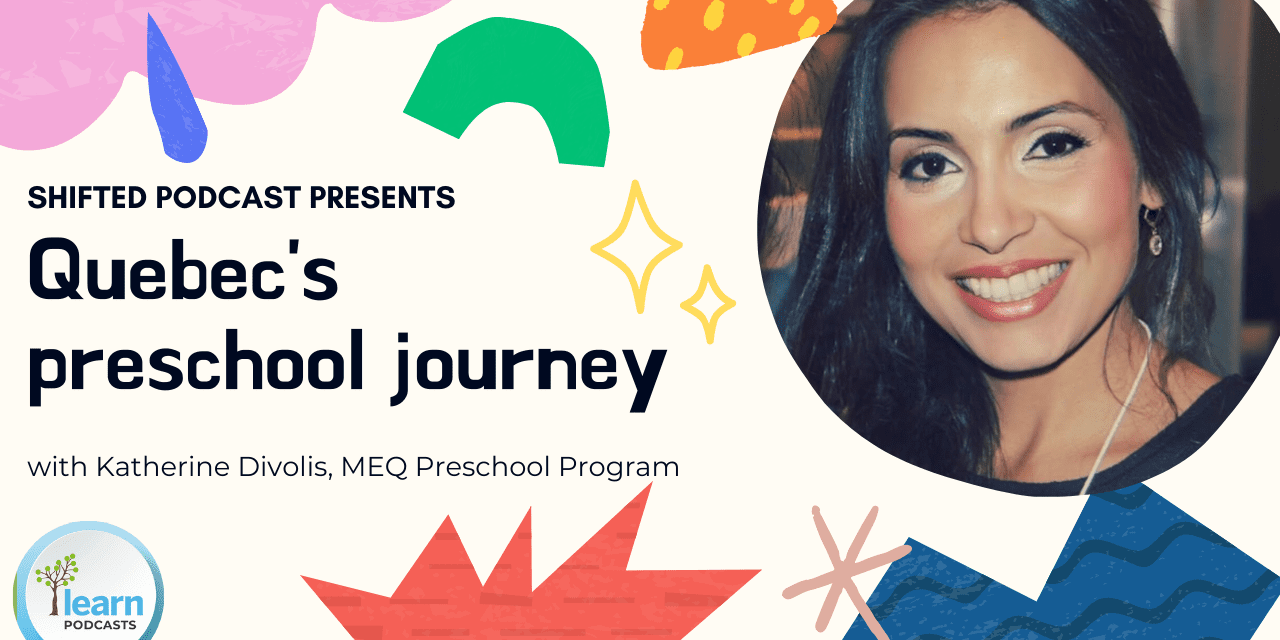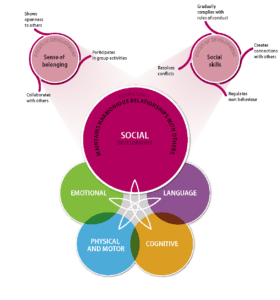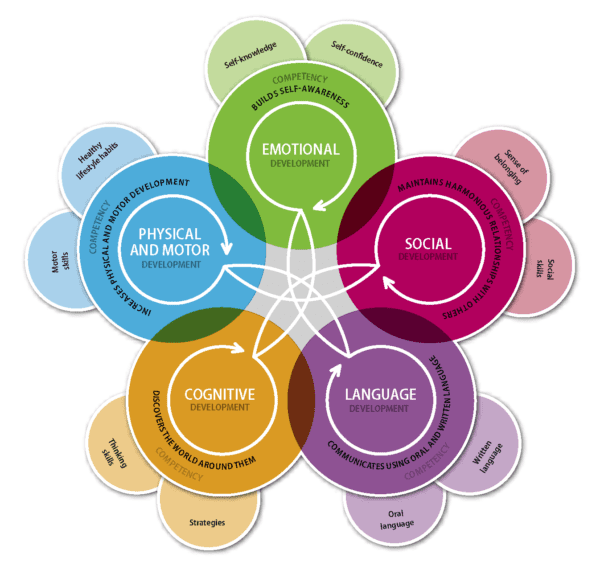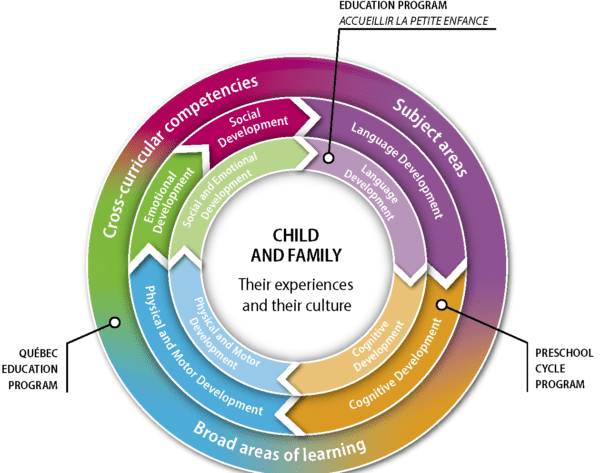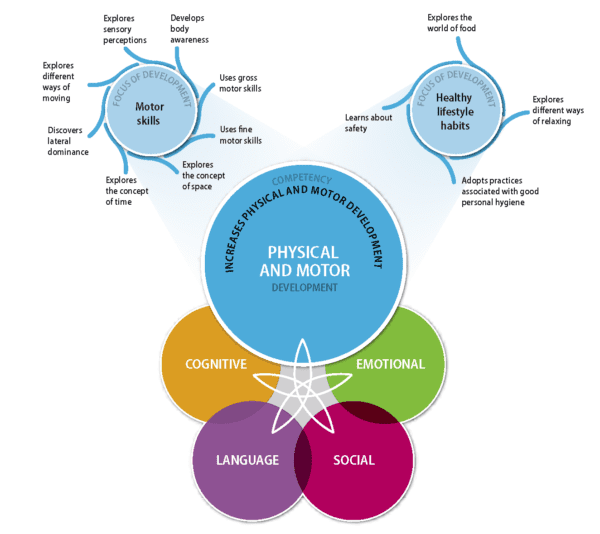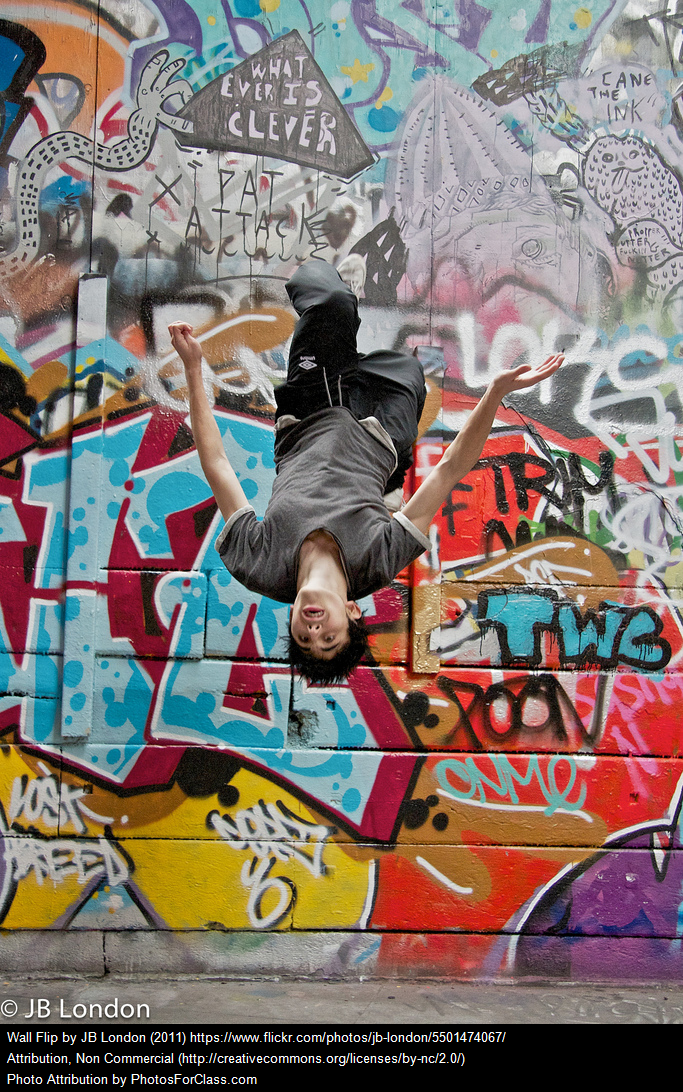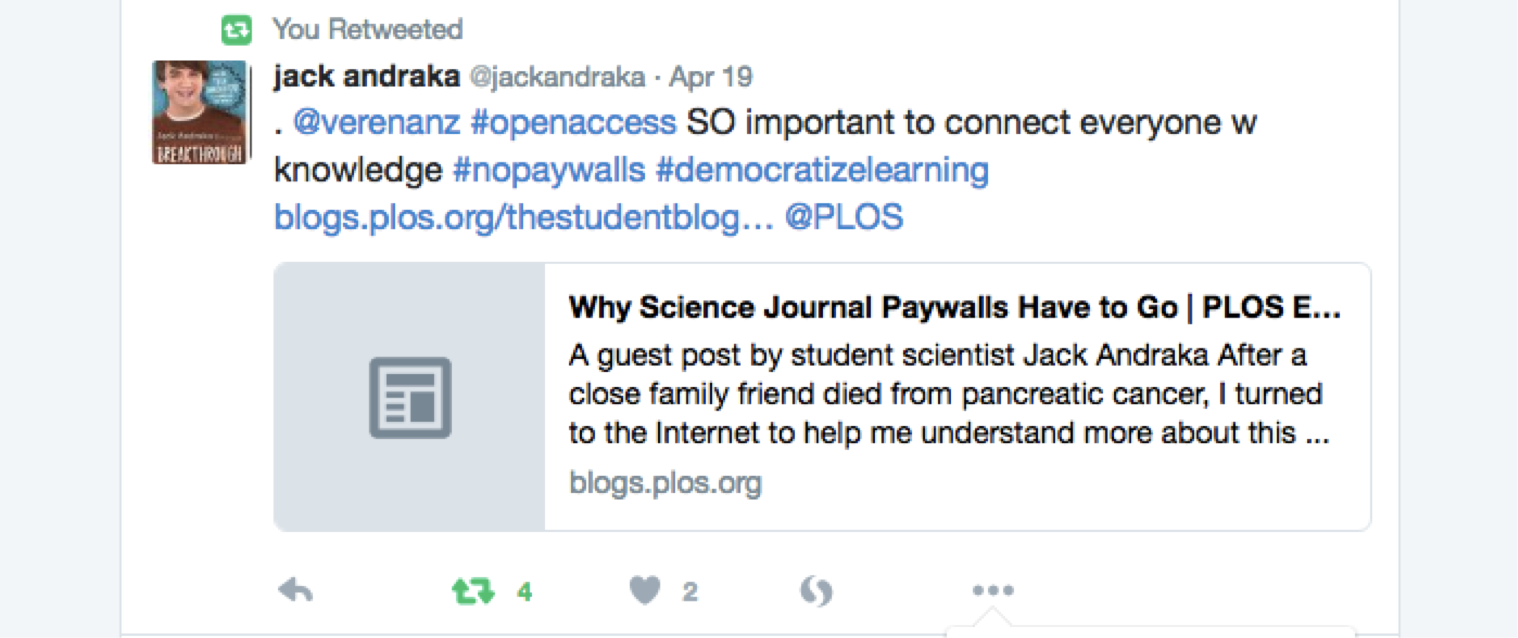Children learn as they play. Most importantly, in play, children learn how to learn.
– O. Fred Donaldson
For this edition of the ShiftED podcast, I had the great privilege of speaking with Katherine Divolis, who is currently working as a Conseillère en éducation préscolaire at the Ministère de l’Éducation et de l’Enseignement Supérieur du Québec (MEQ). We had a rich conversation about the newly revised Preschool Cycle Program that launched in the last school year and is currently being implemented across the province. I highly recommend listening to this podcast episode, as it situates the program, its history, and reveals the heart of the new cycle program with early childhood development and play as key components.
To start off, I want to supplement this podcast episode with some reflections on the program that we didn’t get a chance to include in the final edit. Katherine has been immersed in preschool for close to two decades, and since joining MEQ on a loan of service from Lester B. Person School Board, she’s been spreading the word about “the program [that] was developed to help children reach their full potential.”
The program lays “…the foundations [for] children to develop processes and strategies through classroom routines, engaging in trial and error activities, gathering pointers through guidance and support from teachers or their peers for their play, centres, activities, etc…”.
The emphasis in the Program is always on fostering “…lifelong learning because we are putting in place a class climate that allows the child to develop in [their] learning process and to be equipped for life.” Having this foundation is critical for the smooth transition into elementary school. However, preschool is not preparation for elementary. Preschool must focus on the development of the learner, not on content or subject-specific materials as the program is void of progressions of learning and any content requirements. Thus, this area of development hinges on play! The program places the learner at the center of their learning journey, with every learner advancing at their own pace, in a rich, inclusive environment.
One topic we didn’t get a chance to discuss in detail was professional development for the new preschool program. With every new program comes PD offered by the Ministry. Katherine explained what her team has been up to over the past little while, “The Preschool Education Team of the MEQ has been offering a great deal of training sessions since the beginning of Fall to support teachers in implementing the new program with presentations focusing on the three orientations: child development, evaluation, and intervention.” These three orientations have excellent toolkits and resources that accompany the program which can be found on the MEQ website.
Furthermore, the MEQ has jumped onto YouTube that she describes as a place “…where teachers may view previous training presentations of the Preschool Cycle Program, that they might have missed.” There will also be video presentations on the three orientations available on the channel’s playlist for Preschool. “Play, Classroom Organization, Child Development and soon to come, observation of the child’s progress. The training offered for the winter session is also going to be available.”
In closing, the final question I asked in which I loved her answer, was:
What advice would she give to an educator teaching in the new preschool program?
She simple and poignantly replied,
“The program recognizes play to be the child’s ideal way of learning. How wonderful is that?”
The full discussion is below. An abridged version was recorded for the podcast so content may differ.
You can also listen to the episode as a podcast.
A Conversation with Katherine Divolis
Chris Colley (CC): How long did the Ministry work on the new preschool program?
Katherine Divolis (KD): Well, it was quite the process but I will try to give you a brief overview.
After the Kindergarten for 4-year-olds Program was created close to a decade ago, it was very well received by the K4 teachers but it also sparked an interest on behalf of the K5 teachers who enjoyed many aspects of this K4 program and felt that perhaps it was time for the K5 Program to be updated. There was also the desire to really experience preschool as a cycle not as two separate grades. So then the rest followed:
The Ministry carefully considered the needs of the kindergarten teachers and paid close attention to this request in regards to wanting a cycle program in preschool.
Soon after that, a consultation group was formed (2018) consisting of representatives from all regions of the province which included K4 and K5 teachers from both French and English School Boards of the public school system and the private sector. These were individuals nominated by their respective boards, who did not necessarily know each other but were considered because of their expertise in the field.
There were consultation meetings with the MEQ team where the goal was to take a closer look at both the K4 and K5 programs and discuss what would be significant to retain in regards to child development (and what was different and similar in both programs was also discussed.) This was a long process and took a year of going back and forth where these individuals really took the time necessary to deconstruct both programs.
What came out of that process was a compilation of information that individuals from the field had provided and that really fused both K4 and K5 programs.
The next step was to put it all together and so in 2018, a first version appeared which was reviewed by various stakeholders and partners from the education field, the unions, the AEPQ, University representatives and Professors, and a scientific committee had also been consulted. The consultation process basically involved a large number of specialists that had a level of expertise in child development. There were also other experts that were appointed to conduct research in regards to the characteristics and needs of a 4 to 6-year-old child.
Once the version had been finalized, there was a period where teachers and preschool education consultants had been selected to do a trial run of the program (Not the same teachers that had participated during the consultation process).
Finally, all the comments and reflections that were pointed out during this trial period were considered and final adjustments were made.
As of August 2021, The Preschool Cycle Program became the mandated and sole prescriptive Program for all kindergarten classes in the province.
CC: What was the driving force behind the change in the new cycle preschool program?
KD: First of all, as we just mentioned many teachers had been hoping for a cycle program for a long time. Although the primary and secondary levels are divided into cycles, it was only logical that a developmental program be divided into a cycle as well. In the very first pages of the PFEQ (Quebec Education Program), it states that in a cycle, the organizational mode takes into account the development of skills over time, for example a period of two years. That it allows learning, activities and projects to evolve. It involves long-term pedagogical interventions. That it favors greater pedagogical differentiation practices (PFEQ, p.5). Therefore in preschool education, the cycle is at the service of children’s learning. It offers equal opportunities to develop in different areas in order to succeed and learn throughout life.
CC: What kind of mindset does an educator need to develop to accommodate the new program?
KD: First and foremost, a positive outlook on the importance of play is an absolute must. Secondly, a high tolerance for an elevated noise level is also necessary not just for the teachers but for all those that work around the children in kindergarten. Sometimes, picturing the children as little bees buzzing around a hive constantly developing and learning and full of excitement allows me to paint a clear portrait in my head of what a kindergarten classroom should be all about.
I also think we should keep in mind that by adopting an inclusive and caring stance, we are welcoming children and supporting them in their development to allow them to reach their full potential and also to build their learner’s toolkit for life.
CC: What would a preschool classroom look and feel like in your opinion?
KD: It may of course reflect the personality of its occupants, but above all, it should be a reassuring, welcoming and inclusive environment. It should allow children to develop and learn but also to feel recognized and accepted for who they are: 4-to-6 year old children with their own characteristics and needs. It should be a warm and open space that is physically adapted to the needs of 4-to 6-year old children and be both safe and accessible. A preschool classroom should be organized in such a way as to foster the children’s participation and encourage them to explore different types of play.
Of course, there are some basic principles that cannot be ignored when planning the layout of a kindergarten classroom. For example, the design of the classroom must take into account the five areas of development. It should also take into account the organization of the space and the organization of the day. It is obvious that children need an environment that will stimulate them visually but the most important thing is to design a space that will allow them to feel accepted and recognized for who they are. This inclusive environment will allow children to enjoy learning, offer opportunities for exploration and discoveries.
The ideal room and the ideal materials and accessories is not a realistic expectation but the space should be accessible and safe where the child feels happy, active and engaged. Goal should be: How to foster a space where the child feels well (le bien être).
CC: If I am a new teacher in the preschool program, where would I get the pedagogical support I need to implement the new program?
KD: The Preschool Education Team of the MEQ has been offering a great deal of training sessions since the beginning of the Fall to support teachers in implementing the new Program with presentations that focus on the Program itself, the three orientations, child development, evaluation and intervention.
We also now have our own Youtube channel where teachers may view previous training sessions that they might have missed at their own leisure (on the presentation of the Preschool Cycle Program), Play, Classroom Organization, Child Development and soon to come, Observation of the Child’s Progress. The training offers for the winter session are also going to be available soon. The Educational Services Department from the various school boards or the Educational Consultants have been offering training sessions and supporting the teachers after consulting with us as well. There are also Preschool Educational tools on the MEQ’s site.
CC: If I taught in the old Preschool program, what are the most dramatic shifts I need to take into account with the new program?
KD: For some teachers, it does not feel that there are any dramatic shifts with this new Program. Of course, the idea of the cycle merging both kindergarten for 4-year-olds and kindergarten for 5-year-olds is new and different and there is one less competency in this new Program (competency 6 is no longer there but now integrated).
You see in the old kindergarten for 5-year-olds program, we used to find the competency “To complete an activity or project.” We know that this was much more than completing an activity or project. It actually involved the development of thinking and the cognitive and even metacognitive strategies that children use to carry out their learning. But since this was not a separate issue, it was included in this competency. We do not necessarily feel that there is a dramatic shift because we are still in a developmental program.
CC: What are a few of your coups de coeurs in the new program?
KD: The Program states that play is the child’s ideal way to learn. Also, the focus on inclusion. In the Program, it affirms: “To foster the global development of all children, the mandate of preschool education provides a reassuring, welcoming and inclusive environment” (MEQ, 3). In an inclusive environment, all children and their families will feel accepted and respected. In other words, it is important to take the children’s diversity and individuality into account to provide inclusive education for all.
I also really appreciate that the Program clearly has been conceived in a way as to allow teachers to respond to the needs of the children (La RBE). In many discussion groups where participants have been asked what comes to mind when you consult the Program, the most common response is: The children’s wellness (Le bien-être des enfants). So it is very clear here that the child is at the center of this Program.
Lastly, as a teacher, I was really excited to see that the Program recognizes the importance of the expertise of teachers and talks about how their support helps the children experience success by motivating them and guiding them in their learning. Powerful! Two periods ranging from 45 to 60 minutes of non-stop, continuous and joyful play twice a day where children can learn and develop in all areas, inside the classroom and outdoors as well!
CC: Is the program designed to prepare our youngest learners for grade 1?
KD: Actually, the aim of this Program is to foster lifelong learning because we are putting in place a class climate that allows children to develop in their learning process and to be equipped for life. When the Preschool Cycle Program was being created, it was done so in collaboration with partners in the education network and the scientific community. It was specially designed to give children equal opportunities for development, in order to foster their educational success. The double mandate ensures that as teachers, we will be fulfilling our desire to provide the best possible learning opportunities for Quebec’s children, to help them reach their full potential and to ensure that they will have developed the competencies they will need to facilitate their transition to grade 1.
The program was developed to help children reach their full potential in regards to all five AOD’s and to support the child in his ZPD. In laying the foundations for future schooling (in the Program), we mention that this is about allowing the children to develop processes and strategies (through classroom routines, engaging in trial and error activities, gathering pointers through guidance and support from teachers or their peers for their play, centres, activities, etc…). Thanks to these processes and strategies, the children acquire knowledge related to the different AODs/spheres and also in the subject areas that are part of the Quebec Curriculum (languages, mathematics, arts education, social sciences, science and technology, personal development).
CC: How is preschool different from cycle 1 elementary?
KD: Clearly, the Preschool Cycle Program is a developmental one and the Cycle 1 Program is a disciplinary one. There is no Progression of Learning in Preschool. There is no content that is organized in a way with expectations. We observe children in their development and look carefully at how they are developing in all areas. The time allotted to play is also crucial in kindergarten and it is the first orientation in our Preschool Cycle Program.
In cycle one, there is less time devoted to playing, and as the years go by, even less so. The support that teachers offer is also significant because, in preschool, the children are supported in all areas of development. The Organization of the classroom is another one of the three orientations and it is considered very carefully as the classroom environment in which the child plays and engages in all types of learning opportunities, should respond to the needs of a 4 to 6-year-old child. It should be organized in a way to equip them with all that they need to develop and learn.
CC: What advice would you give to all teachers implementing the new program?
KD: I would say that it is a wonderful time to be a kindergarten teacher so enjoy it! This new Program places the child at the center and acknowledges the fact that children should be given enough time to explore and learn at their own pace. The program recognizes play to be child’s ideal way of learning. How wonderful is that? The emphasis is on indoor play just as much as on outdoor play.
It also recognizes the teacher’s expertise and promotes school-family and community collaboration. The cycle gives time to the child to learn and it also gives the teacher an opportunity to respect the pace of the child in his/her development.
The Program has everything to guide the teachers in their learning process to implement it as well. It is user-friendly, the table of AODs is colorful, the colors have been carefully selected to reflect the spheres of development. The key features are present, there are also observable behaviours to guide the teachers in their observations, but also to guide them in their planning. It has been well written and as we mentioned earlier all the research that was conducted in order to create the Program.
I would also say to the teachers that it is so easy to embrace this Program as it has everything we need to feel recognized, to feel happy, and confident in our profession as we have been given a Program that will help our little bees learn and develop so many strategies. A tool, that allows us to look at what the child can do and to reflect on the interventions we need to put in place to support the child.
I am quite envious of teachers right now and cannot wait myself to return to my kindergarten classroom to implement the Preschool Cycle Program and watch my students buzz around with excitement, eager and happy to be coming to school everyday to learn and to develop to their full potential!
References
Ministère de l’éducation (2021). Programme de formation de l’école québécoise: Programme-cycle de l’éducation préscolaire. http://www.education.gouv.qc.ca/fileadmin/site_web/documents/education/jeunes/pfeq/Programme-cycle-prescolaire-AN.pdf

